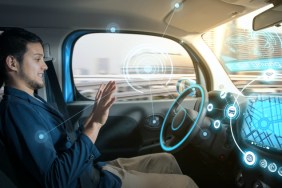While every edition of the Consumer Electronics Show has its own themes and focuses each year, CES 2015 is remarkably car-centric — making it a mini auto show a few days away from the onrushing NAIAS 2015 in Detroit.
With a future full of self-driving cars already a big story at CES, the automotive technology company DENSO is pushing forward on V2X – the science of building a network of cars that talk to each other, pedestrians, stop lights and other items encountered on the travel grid.
V2X produces essentially a modified wifi signal that puts out an anonymous signal to ID its own car’s position, speed, course, etc. Meanwhile, that same signal is detecting the V2X transmission from other cars, as well as pings from pedestrians with smartphones, transmitting stoplights, traffic sensors and other road staples. With the system widely applied across the automotive world, V2X looks to eliminate collisions, alleviate traffic jams, prevent pedestrian accidents, improve fuel economy, etc.
The thinking behind V2X and DENSO’s work states about 90% of crashes are driver error. The rest are mechanical errors. So, if cars can stop or evade safely and automatically, road safety obviously improves.
The V2X transmitter and receiver sends out a signal multiple times per second, communicating with all other similarly equipped cars on the road. Since the system would be useless if only some makes and models were equipped. A regulated set of equipment and signal needs to work with Ford, GM, Toyota, Honda, Acura, Nissan, Infiniti, Mercedes-Benz, Audi/VW, Hyundai/Kia, and so forth. Busses, trucks and motorcycles will also have to get on board.
Related: Las Vegas City Guide
That’s where DENSO steps in, since its in-car technology is already present in makes across the spectrum. You may not know it, but DENSo tech probably lives in the electronic mind of your current engine. Since DENSO already knows how to curve the same tech across multiple cars, it’s a strong choice for designing a network that, if deployed, will one day have to include all of those vehicles.
The same technology is transferable to traffic lights, congestion censors and cell phones and other on road technologies to further enhance driver and pedestrian safety. DENSO is looking to enhance the smart signal to read for prime pedestrian concerns — sensing if someone is walking while texting or talking on the phone and therefore a higher risk of collision because he or she is not paying attention.
Of course, early concerns in this age of surveillance include worries that government officials or corporate concerns could track cars, tax usage or monitor speeds for remote tickets. Roger Berg, DENSO Vice President of Wireless Technologies, said that V2X won’t be in cars and on the travel grid before these legal issues and regulatory questions are decided. However, plans are to make the technology based on anonymous IDs to avoid these concerns.
“V2X was a cooler topic at last year’s CES because these real world regulatory issues weren’t involved yet,” Berg said. “As we get closer to seeing the technology become reality, the details of making that happen become less futuristic.”
Berg and other experts don’t see regulations concluded on the technology until 2016 at the earliest, with deployment underway by 2018. Late model vehicles would be able to buy a kit that retrofit the V2X once the network is in place.







